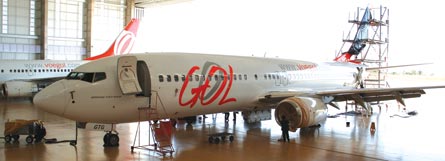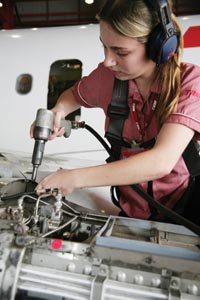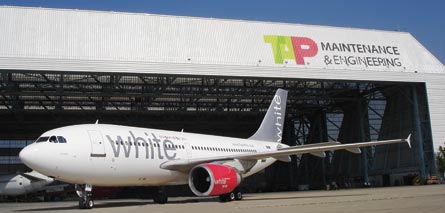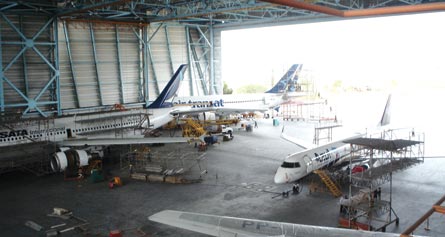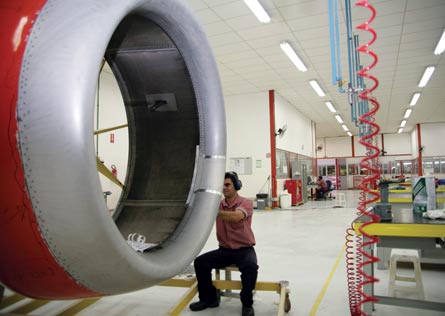São Carlos seems an unlikely place to be a major international maintenance hub, but if Latin America's largest airline group gets its way, the small Brazilian city with no commercial air service could become the next Hamburg or Singapore.
TAM, which opened a heavy maintenance hangar at São Carlos in 2001, plans a major expansion of its MRO business that would see it more than double in size with possible support from an overseas strategic partner. The expansion is needed to not only support TAM's own fleet, which has grown exponentially since the demise of former Brazilian flag carrier Varig, but also provide enough capacity to meet TAM MRO's ambitious plans for expanding its third-party business.
|
|---|
TAM has been maintaining third-party aircraft, mainly from other Brazilian operators, since 2005 but until now has lacked the capacity to aggressively pursue work from outside the region. "The market was knocking on our door and there was an indication it could be a good business," says TAM vice-president of operations and MRO Ruy Amparo.
TAM MRO has a limited narrowbody-only third-party business that accounts for about 15% of its revenues. But Amparo sees this growing to up to 50% as TAM builds a second airframe maintenance hangar at São Carlos and attempts to forge joint ventures with major international MRO players.
TAM MRO was corporatised last year and has since been running as an independent business unit. Amparo says a decision to formally spin off the unit is expected soon and, once separated, TAM MRO aims to sign partnerships deals with major international maintenance firms that would help expand its capacity and capability.
|
|---|
Last year Goodrich opened an engine inlet and fan cowl repair shop within TAM's São Carlos facility and Osorio says there is ample space at the centre for more partners. "We want to expand this and bring in someone with expertise and technology," he adds.
He says TAM is already committed to expanding its MRO facility at São Carlos, including opening in 2012 a new hangar that would give it three widebody maintenance lines compared with the current one and at least doubling the size of its landing gear shop. But having a strategic partner or partners would help accelerate the expansion. "We've decided to grow with or without a partner. The only thing which will change is the speed," Osorio says.
Brazil's other large MRO provider, TAP Maintenance & Engineering Brazil, formerly known as VEM, is also on the hunt for a new partner/investor. VEM was the maintenance unit of Varig until 2005, when Portugal's TAP purchased a controlling stake.
"Since TAP acquired VEM we've been looking for a strategic partner," says Nestor Koch, president of TAP M&E's Brazil unit. "Some international companies are looking at us. TAP is not selling the company but looking for a third-party company to bring value."
Koch says the strategic partner could be a leading international MRO firm or an airline. He believes TAM, despite its own ambitious plans to expand and overtake TAP as Brazil's largest MRO provider, would be the perfect partner. "We'd really appreciate the value TAM could bring in TAP," he says.
Koch reveals that the two companies have discussed merging their MRO businesses or establishing a joint venture for some time. "This is not a new discussion. It happened two years ago," he says. "I'm not sure [a deal] will happen this year - probably not. The companies are looking, but discussions are not deep enough for a merger."
Koch also sees the potential of a three-way deal involving TAP, TAM and a major international MRO firm. But he acknowledges that TAP and TAM may also end up partnering rival international MRO firms, leading to even more competition between the two MRO providers.
At least for now TAM is moving ahead independently and sees TAP as a weaker competitor. TAM executives claim TAP Brazil has been struggling financially and is overridden with debt. Koch says the past year has been financially challenging and TAP Brazil's hangars operated in 2009 at only 50% capacity. He says 2009 "was the worse year for aviation business. It dropped a lot - for everyone and for us."
But he says market conditions have since improved and in May TAP Brazil was operating at 90% capacity. Koch also points out that last September TAP paid off the remaining debt left from when Varig owned VEM. Koch says resolving the debt issue was "very huge" because it allowed TAP to finally transfer to its own name most of its maintenance hangars and allowed the company to again pursue government contracts including from the Brazilian air force.
Given Brazil's relatively low labour costs and vast aerospace experience that has already propelled Embraer to become the world's third largest commercial aircraft manufacturer, there is no reason to believe the country cannot support multiple international MRO players.
Expansion of Brazil's MRO sector is needed to keep up with the country's own domestic aviation market, which has bucked the global downturn by growing over the past year at a clip exceeding 30%. Brazil's MRO firms are also well positioned to tap into the fast growth of the aviation market in broader Latin America and become a new source for airlines in North America and Europe that use Asia or other low-cost regions for maintenance.
|
|---|
POTENTIAL CUSTOMERS
Osorio says there are several Boeing 777 and 767 operators that already fly into São Paulo, which is 230km (125nm) from São Carlos. Several of these operators are seen as potential customers for TAM MRO, which added 767 airframe capabilities last year and plans to introduce 777 overhaul capabilities in the first half of next year. TAM added its first widebody capability in 2003, when it extended São Carlos' only runway to accommodate Airbus A330s, but is only now starting to pursue potential A330 third-party customers.
Last year TAM MRO completed 13 widebody heavy maintenance checks - all on TAM aircraft. It completed 106 narrowbody checks, including 33 from third-party customers. All these customers were from Latin America or the Caribbean but Amapro is confident that US Federal Aviation Administration certification, which TAM MRO secured last year, will open up new markets further north.
Brazil's second largest carrier, Gol, also plans to use FAA certification to pursue expansion of its third-party maintenance business. The airline's recently expanded MRO facility in Belo Horizonte is now certificated only by Brazil's ANAC, which limits the carrier to working on Brazilian-registered aircraft. But Gol executive vice-president technical Fernando Rockert de Magalhaes says the carrier's MRO unit has just begun the process of applying for FAA certification and expects to secure FAA certification by the end of 2011.
"We plan to do some services to foreign airlines. We don't know yet who we can get. The first step is to get FAA certification. After that we'll go out and see what we can get," Rockert says, adding that applications for other certification, including European Aviation Safety Agency approval, are likely.
He adds that being able to work only on Brazilian-registered aircraft is a huge limitation because Brazil "is only a small part of the supply" globally. Gol has two third-party customers - both small Brazilian Boeing 737 operators - but has capacity for more. Gol's MRO centre is now capable of overhauling or upgrading 120 737s annually, up from 60 before the expansion project was completed in March.
Gol, which is capable of performing heavy checks on 737 Classics and Next Generation 737s, plans to initially focus on third-party marketing activities on other Latin American countries. "Considering the range of the aircraft most of the clients would probably be South American companies," Rockert says, adding there are "a lot of companies operating 737s in South America" including several smaller airlines that do not have in-house maintenance capabilities.
Koch believes TAP has already proven Brazil is capable of securing work in the highly competitive international third-party MRO market. He says before being sold to TAP, VEM relied on Varig for 88% of its revenues with the remaining 12% mainly coming from other Brazilian customers. "There was very little outside Brazil," Koch says.
|
|---|
LEASE COMPANIES
But, he adds, today only 35% of TAP Brazil's revenues are generated from contracts with Brazilian customers and a majority of its revenues now come from work for international leasing companies. He acknowledges this reliance on lessors has been a weakness recently as lessors opted to park large chunks of their fleets during the economic downturn. Koch says TAP Portugal "suffered much less than we did last year because Portugal has long-term relationships with big customers".
But TAP Brazil, which benefits from TAP Portugal's relationships as it often receives European-registered aircraft when the Lisbon facility is at full capacity, is confident it will in future be able to secure more work directly from airlines. Koch says the leasing market is also starting to pick up again as a recovery in demand is now allowing lessors to place aircraft that had been parked. "We expect this year will be a very stable year," Koch says.
Despite its recent struggles, TAP Brazil is still the largest maintenance firm in Latin America, with 10 maintenance lines spread across two facilities. It currently has four widebody maintenance lines at Rio de Janeiro's Galeao airport and five narrowbody lines plus one widebody line at Porto Alegre.
Koch says the company is focusing on improving utilisation and efficiency rather than expansion. He says TAP is in the process of introducing lean production techniques, which should reduce heavy check times by 15%.
|
|---|
While Koch says TAP Brazil has no plans to add airframe maintenance lines for at least the next two years, he says the company plans to introduce capability for the A320 in the fourth quarter of this year. TAP Brazil is already certificated to work on virtually every other major aircraft type - including the Airbus A310, A330, A340 and Boeing 737, 757, 767, 777, MD-11- and earlier this year became an Embraer authorised service centre (see sidebar).
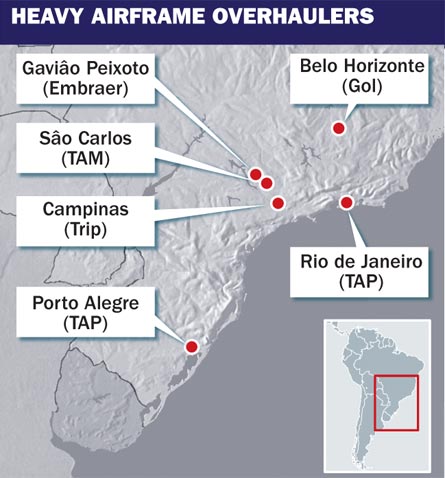 Koch says TAP Brazil also has a large and profitable component business, which accounts for about 30% of the company's revenues and has been much more stable than its airframe business during the current downturn. He says the firm, which now services turboprop engines, is also looking at re-establishing overhaul capability for jet engines with possible support from a foreign partner.
Koch says TAP Brazil also has a large and profitable component business, which accounts for about 30% of the company's revenues and has been much more stable than its airframe business during the current downturn. He says the firm, which now services turboprop engines, is also looking at re-establishing overhaul capability for jet engines with possible support from a foreign partner.
Amparo says TAM MRO is also working on efficiency improvements that could reduce the time of a D check from four to three weeks. He says TAM also has the flexibility to increase output by adding a third shift.
TAM's São Carlos single airframe maintenance hangar now houses one 767/A330 widebody line, two A320 lines and three Fokker 100 lines plus a paintshop that can accommodate one Fokker 100 or A320. In addition to building a new two-widebody hangar, TAM plans to enlarge the current hangar by the middle of next year. The enlarged hangar will give TAM the flexibility of adding a third A320 line or keeping the existing two A320 lines and fitting in a 777 in the one widebody line that is now limited to 767s or A330s.
Amparo says "there's a lot of room" for further expansion at São Carlos, but TAM may also eventually open a second facility in Campinas if a government plan to convert Viracopos into São Paulo's future international airport comes to fruition.
TAM performs heavy checks only at São Carlos, having moved all maintenance except light checks from its congested hubs at São Paulo Congonhas and Guarulhos airports. Amparo says São Carlos is the ideal location for heavy maintenance despite the ferry costs TAM incurs in repositioning aircraft from São Paulo because it has no restrictions on night operations and the lowest tax rate in Brazil.
Rockert says Gol initially selected Belo Horizonte's Confins airport in 2005 for its MRO centre because of its favourable climate, long runway and little congestion. Rockert says Gol also has room to expand and has already completed the "documents" needed to construct an additional hangar at Confins. "It all depends on the market. We have space to grow 50% to 70% if required," he says.
For now Gol is focusing on spooling up its existing building, which is operating at 75-80% capacity. "We're expanding the workforce," Rockert says. "It's not easy to recruit workers and adapt and train them to our standards."
MECHANICS
He says Gol has 800 mechanics in Belo Horizonte, including 150 added this year, but requires another 200 to fully use all of eight of the facility's maintenance lines. He says since Gol opened its MRO centre at Confins it has trained 400 employees locally with support from area schools. After the expanded facility was completed earlier this year Gol also relocated mechanics from other bases, where the carrier previously did some overnight checks.
Rockert says as Gol continues to spool up its MRO centre most of the additional capacity will be taken up by its own fleet. "We're now prepared for huge growth in the airline," he says. "We're planning not only two years ahead but five years ahead."
But he adds that there should also be some space to test the international third-party market. He says FAA certification will also allow Gol to perform pre-return checks on its own 737s as they exit its fleet.
Gol has a fleet renewal plan that involves it returning 10-20 737-700/800s a year as new 737NGs are delivered. But leasing companies typically require aircraft to be returned with a fresh check performed by a maintenance company with recognised international certification - otherwise aircraft cannot be moved to an operator in another country.
As a result, Gol now has to pay other maintenance companies, primarily TAP Brazil, to perform these pre-return checks.
BRAZIL’S MRO SHOPS RACE TO ADD E-JET CAPABILITIES
Embraer's decision to focus on military and corporate aircraft at its Brazilian maintenance centre has opened opportunities for Brazil's other MRO providers to service the region's fast growing E-Jet fleet.
In May Embraer appointed TAP Maintenance & Engineering Brazil as its first authorised service centre in Latin America. Embraer vice-president for the Latin America airline market Luiz Hamilton Lima says the manufacturer decided to pursue partnerships with Brazilian MRO firms after realising that there is not enough capacity at its own MRO facility in Gavião Peixoto to meet the region's need for E-Jet maintenance services.
"There was a strategic decision by Embraer to concentrate our Gavião Peixoto facility to other areas of aviation like defence and somewhat to executive," Lima says. "That's why we started working six months ago with TAP to qualify them as an MRO in Brazil."
|
|---|
Lima adds Embraer is "absolutely interested" in appointing additional authorised service centres in Brazil and elsewhere in Latin America. TAM MRO strategic planning manager Carlos Osorio says the maintenance company is already in talks with Embraer to become an authorised service centre as TAM's São Carlos facility prepares to introduce capability for the E-Jet. Lima responds: "We would be more than happy to qualify TAM in São Carlos. They have a huge and very complete facility there."
TAP Brazil's Porto Alegre facility earlier this year introduced capability for the E-jet, becoming only the second shop in South America after Embraer's Gavião Peixoto facility with the capability. TAP M&E Brazil president Nestor Koch says the company began working on its first E-Jet in March and has been contracted by Brazilian low-cost carrier Azul to complete 4,000h and 6,000h checks on 15 E-190/195s up to March 2011.
TAP Brazil is also now certificated to perform the more extensive 24,000h check on E-Jets.
Koch is hopeful of securing long-term maintenance contracts from Aerolineas Argentinas subsidiary Austral, which will take delivery of the first of 20 E-190s this month, Azul and Trip - a fast-growing Brazilian regional carrier that operates six E-175s. But Osorio says TAM is also competing for these contracts and is confident it will take over maintenance responsibility for Azul's fleet after the carrier's current one-year contract with TAP ends.
Azul, which has no plans to establish its own heavy maintenance capabilities, operates 18 E-190/195s with nearly 50 more on order. Trip has its own heavy maintenance base at Campinas outside São Paulo, where it overhauls its fleet of 25 ATR 42/72s, but president Jose Mario Caprioli dos Santos says the carrier for now has no plans to establish a capability for E-Jets and will instead look to outsource this work.
Osorio says TAM will "start the process of being prepared for E-190s" later this year and its São Carlos facility should be ready to begin work on E-Jets in early 2011. It plans to add the capability based entirely on demand from other South American carriers as TAM does not operate E-Jets although it is evaluating acquiring E-195s. "We need to increase our capability and increase our capacity and then go after clients," Osorio says.
TAM and TAP executives claim the market is big enough to support two E-Jet MRO providers in Brazil, pointing out how well the E-Jet has been selling throughout Latin America. Osorio says adding services for the E-170/190 and ATR 42/72 will help TAM MRO fill space at the back of its hangar as demand for its Fokker 100 heavy maintenance product wanes.
TAM's São Carlos introduced capability for the ATR 42/72 in June. For now it is overhauling the ATR 42 fleet operated by Pantanal, a small regional carrier that TAM acquired at the end of last year, but TAM MRO has also begun pursuing third-party work from other ATR operators in the region.
While only recently being appointed an Embraer authorised service centre and adding E-jet capabilities, TAP Brazil has been servicing ERJ-135/145s and EMB-120s for several years. Lima says becoming factory-authorised means TAP in addition to meeting the requirements of Brazil's ANAC has now followed Embraer's own qualification processes and acquired specific tooling.
Source: Flight International





















